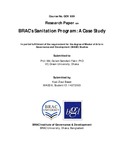| dc.contributor.advisor | Fakir, Md. Golam Samdani | |
| dc.contributor.author | Baset, Kazi Ziaul | |
| dc.date.accessioned | 2018-01-09T10:16:38Z | |
| dc.date.available | 2018-01-09T10:16:38Z | |
| dc.date.copyright | 2017 | |
| dc.date.issued | 2017 | |
| dc.identifier.other | ID 14272003 | |
| dc.identifier.uri | http://hdl.handle.net/10361/8997 | |
| dc.description | This research paper is submitted in partial fulfilment of the requirements for the degree of MA in Governance and Development, 2017. | en_US |
| dc.description | Cataloged from PDF version of thesis report. | |
| dc.description | Includes bibliographical references (page 117). | |
| dc.description.abstract | Bangladesh has made significant progress in the field of sanitation. Bangladesh Government
and some NGOs are working to fulfill the targets set for sanitation in the Millennium
Development Goals and the more ambitious national goals that seek to achieve 100% sanitation
by 2010.In the sanitation arena BRAC’s WASH program is a unique one. BRAC’s WASH was first
launched in 2006 with support from Netherlands in 152 Upazilas (sub-districts). BRAC has
currently provided access to hygienic latrines for 41.6 million people, safe water options for 2.3
million people, and hygiene education to an estimated 13.9 million people per year in
communities and 2.9 million people per year in schools on average.
On the other hand, as a Government institution, DPHE under Local Government Division
exclusively responsible for sanitation and water supply in mainly Upazila and Zila level. There
are many local government bodies like Upazila Parishad, Union Parishad and NGOs such as
BRAC are trying to achieve 100 % sanitation coverage. Local DPHE office, UNO office and NGOs
like BRAC are operating in the Upazila area specifically. To get the expected success
coordination is very important among those bodies.
My research work is an empirical study of WASH program in Bholahat Upazila,
Chapainawabganj district. The objective of this thesis is to find out whether the WASH program
is successfully helping the local residents of the Upazila to improve their health conditions or
not. And how the coordination and collaboration of the local administration and NGOs are
working in the sanitation sector to achieve success, I tried to find out that in my thesis.
From twenty one respondents, 100 percent are satisfied about the coordination and
collaboration of BRAC’s WASH with the local administrative bodies. As per the respondents,
28.58 percent are satisfied and 71.42 percent marked as good without any bad opinion on the
program activities. Four case studies have been done to get a clear picture of the scenario of
sanitation in the selected area.
Eventually, some recommendations and further scope of studies have been given in the last
chapter that would be helpful for the proper authority, policy makers and upcoming
researchers concerned with water, sanitation and hygiene sector. | en_US |
| dc.description.statementofresponsibility | Kazi Ziaul Baset | |
| dc.format.extent | 120 pages | |
| dc.language.iso | en | en_US |
| dc.publisher | BRAC Univeristy | en_US |
| dc.rights | BRAC University theses are protected by copyright. They may be viewed from this source for any purpose, but reproduction or distribution in any format is prohibited without written permission. | |
| dc.subject | BRAC | en_US |
| dc.subject | Sanitation | en_US |
| dc.subject | Bholahat upazila | en_US |
| dc.title | BRAC’s sanitation program: a case study | en_US |
| dc.type | Thesis | en_US |
| dc.contributor.department | BRAC Institute of Governance and Development, BRAC University | |
| dc.description.degree | M. Governance and Development | |

